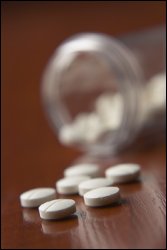Pharmaceutical Pollution: What it is, and How Pharmaceutical Pollution Threatens Your Health
by www.SixWise.com
Americans are prescribed millions of doses of prescription
drugs every year. Livestock are given millions more. But after
the pill has been swallowed or the injection taken, the active
components of the drugs do not become inert or completely
absorbed by the body.
|

One study found that 80 percent of streams tested contained
antibiotics, steroids, synthetic hormones or other common
drugs.
|
Far from disappearing, the drugs are excreted and now, scientists
are finding, prescription drugs are showing up in our ground
water, soil, waterways and even our drinking water. That's
because our conventional sewage treatments may not be looking
for drugs, and certainly don't always remove them.
Adding to the problem are prescription drugs that aren't
used, then are flushed down the toilet or deposited in landfills
-- ultimately ending up in the environment.
This so-called "pharmaceutical pollution" could
have major implications on wildlife, agriculture and humans
-- yet is only beginning to be studied.
"This is an important new research area," said
A. Lynn Roberts, leader of a Johns Hopkins team that began
a study to determine the scope of pharmaceutical pollution
in the United States. Roberts continued:
"Over the past few years, scientists in Europe have
found pharmaceuticals in natural waterways, sewage treatment
effluents and even in drinking water. Yet until this year
[2003] there have been virtually no scientific studies examining
this issue in the United States. It's important that we begin
to look at this because there are many ways in which pharmaceuticals
in the environment could produce undesirable effects on aquatic
organisms or even humans."
How Widespread is the Problem?
Current estimates are still being gathered, but a study conducted
in 1999-2000 by the U.S. Geological Survey (USGS) found that
most waterways contain at least some antibiotics, steroids,
synthetic hormones or other common drugs. Out of 139 streams
in 30 states, they found:
-
About 80 percent contained trace amounts of contaminants
-
Half the streams contained seven or more chemical compounds
-
One-third of the streams contained 10 or more compounds
- One water sample contained 38 chemicals
"We're not talking about rampant dumping," said
one USGS survey official. "We're looking at the effect
of normal existing usage for these different chemicals."
Just how many drugs are we using currently? A lot. Here are
some statistics just for antibiotics (not including any other
types of drugs):
When a drug is taken, experts say up to 90 percent may be
excreted back into the environment, unchanged.
What kinds of drugs -- and to what extent -- are currently
out there is anyone's guess. Padma Venkatraman, a postdoctoral
fellow at Johns Hopkins who is part of the research team,
believes the drugs most likely to be found at "toxicologically
significant levels" include:
-
Antidepressants
-
Anti-convulsants
-
Anti-cancer drugs
-
Anti-microbials
"We're trying to make an intelligent guess as to what's
out there in the environment and what's probably toxic,"
Venkatraman said.
Antibiotic-Resistant Bacteria on the Rise
|

Up to 90 percent of a drug you consume may be excreted
-- unchanged.
|
Just one problem stemming from pharmaceutical pollution is
antibiotic-resistant bacteria. When drugs are excreted in
waste, the compounds linger in the environment. In the case
of livestock waste, the antibiotic-laced manure is spread
directly onto farm crops as fertilizer. From there it may
run off into nearby streams.
The result is that bacteria is able to mutate into strains
that are resistant to the widely spread antibiotics, paving
the way for infections that cannot be easily cured.
According to the Centers for Disease Control and Prevention,
about 2 million people in hospitals get infections each year,
which cause 90,000 deaths. Of these, more than 70 percent
of the bacteria that causes these infections are resistant
to at least one common antibiotic that is typically used to
treat them.
Health Problems Remain a Mystery
"Little is known about the potential interactive effects"
from complex mixtures of waste contaminants in the environment,
according to USGS.
For instance, Roberts pointed out that antidepressants work
by altering levels of serotonin. However, serotonin causes
many aquatic creatures to spawn. The result could be that
prescription drugs may alter breeding cycles in the wild.
Further, drugs can have major impacts on developing fetuses
in humans. If small amounts showed up in drinking water, it
could cause birth defects or other problems.
"Pharmaceuticals have high biological activity,"
Roberts said. "We may be able to tolerate them for a
short period of time, but that doesn't mean they won't hurt
us -- or developing fetuses or aquatic organisms -- at higher
concentrations or over a long period of time."
There is good news, and that is that attention to this issue
is growing, and so is the drive to find out just what types
of problems may be occurring.
The USGS agrees, stating in their report that "protecting
the integrity of our water resources is one of the most essential
environmental issues of the 21st century."
Recommended Reading
Is
There Radon in Your Drinking Water?
27
"Never Events": They're Not Supposed to Happen,
but They Often Do
Sources
Microbes
in Manure can Minimize Pharmaceutical Pollution
New
Study Says Pharmaceutical Wastes Taint U.S. Waters
Aware
Antibiotic Facts
Battle
of the Bugs: Fighting Antibiotic-Resistant Bacteria
Prescription
Drug Pollution may Harm Humans, Aquatic Life
Potential
Impact of Pharmaceuticals on Environmental Health
More
Waters Test Positive for Drugs